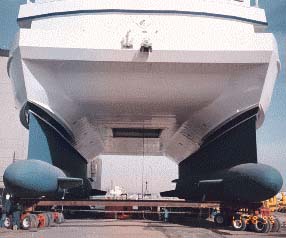
Blue Marlin and her sister ship MV Black Marlin comprise the Marlin class of semisubmersible heavy-lift ships operated by Dockwise Shipping of the Netherlands. Designed to transport very large, semisubmersible drilling rigs above the transport ship's deck, she is equipped with 38 cabins to accommodate 60 people, a workout room, sauna and swimming facilities, and a secure citadel for protection against pirate attacks.

An oil platform is a large structure with facilities to extract and process petroleum and natural gas that lie in rock formations beneath the seabed. Many oil platforms will also have facilities to accommodate the workers, although it is also common to have a separate accommodation platform bridge linked to the production platform. Most commonly, oil platforms engage in activities on the continental shelf, though they can also be used in lakes, inshore waters, and inland seas. Depending on the circumstances, the platform may be fixed to the ocean floor, consist of an artificial island, or float. In some arrangements the main facility may have storage facilities for the processed oil. Remote subsea wells may also be connected to a platform by flow lines and by umbilical connections. These sub-sea facilities may include of one or more subsea wells or manifold centres for multiple wells.
The Gibbs Brothers Medal is awarded by the U.S. National Academy of Sciences for "outstanding contributions in the field of naval architecture and marine engineering". It was established by a gift from William Francis Gibbs and Frederic Herbert Gibbs.

A submersible is a watercraft designed to operate underwater. The term "submersible" is often used to differentiate from other underwater vessels known as submarines, in that a submarine is a fully self-sufficient craft, capable of independent cruising with its own power supply and air renewal system, whereas a submersible is usually supported by a nearby surface vessel, platform, shore team or sometimes a larger submarine. In common usage by the general public, however, the word "submarine" may be used to describe a craft that is by the technical definition actually a submersible, and by the standard meaning of the word, all submarines are submersibles.

A semi-submersible platform is a specialised marine vessel used in offshore roles including as offshore drilling rigs, safety vessels, oil production platforms, and heavy lift cranes. They have good ship stability and seakeeping, better than drillships.

A small waterplane area twin hull, better known by the acronym SWATH, is a catamaran design that minimizes hull cross section area at the sea's surface. Minimizing the ship's volume near the surface area of the sea, where wave energy is located, minimizes a vessel's response to sea state, even in high seas and at high speeds. The bulk of the displacement necessary to keep the ship afloat is located beneath the waves, where it is less affected by wave action. Wave excitation drops exponentially as depth increases, so wave action normally does not affect a submerged submarine at all. Placing the majority of a ship's displacement under the waves is similar in concept to creating a ship that rides atop twin submarines.

A drillship is a merchant vessel designed for use in exploratory offshore drilling of new oil and gas wells or for scientific drilling purposes. In recent years the vessels have been used in deepwater and ultra-deepwater applications, equipped with the latest and most advanced dynamic positioning systems.

A ballast tank is a compartment within a boat, ship or other floating structure that holds water, which is used as ballast to provide hydrostatic stability for a vessel, to reduce or control buoyancy, as in a submarine, to correct trim or list, to provide a more even load distribution along the hull to reduce structural hogging or sagging stresses, or to increase draft, as in a semi-submersible vessel or platform, or a SWATH, to improve seakeeping. Using water in a tank provides easier weight adjustment than the stone or iron ballast used in older vessels, and makes it easy for the crew to reduce a vessel's draft when it enters shallower water, by temporarily pumping out ballast. Airships use ballast tanks mainly to control buoyancy and correct trim.

A moon pool is a feature of marine drilling platforms, drillships and diving support vessels, some marine research and underwater exploration or research vessels, and underwater habitats, in which it is also known as a wet porch. It is an opening in the floor or base of the hull, platform, or chamber giving access to the water below, allowing technicians or researchers to lower tools and instruments into the sea. It provides shelter and protection so that even if the ship is in high seas or surrounded by ice, researchers can work in comfort rather than on a deck exposed to the elements. A moon pool also allows divers, diving bells, ROVs, or small submersible craft to enter or leave the water easily and in a more protected environment.
Marine architecture is the design of architectural and engineering structures which support coastal design, near-shore and off-shore or deep-water planning for many projects such as shipyards, ship transport, coastal management or other marine and/or hydroscape activities. These structures include harbors, lighthouses, marinas, oil platforms, offshore drillings, accommodation platforms and offshore wind farms, floating engineering structures and building architectures or civil seascape developments. Floating structures in deep water may use suction caisson for anchoring.

Offshore drilling is a mechanical process where a wellbore is drilled below the seabed. It is typically carried out in order to explore for and subsequently extract petroleum that lies in rock formations beneath the seabed. Most commonly, the term is used to describe drilling activities on the continental shelf, though the term can also be applied to drilling in lakes, inshore waters and inland seas.
"Offshore", when used in relation to hydrocarbons, refers to operations undertaken at, or under the, sea in association with an oil, natural gas or condensate field that is under the seabed, or to activities carried out in relation to such a field. Offshore is part of the upstream sector of the oil and gas industry.

Mighty Servant 3 is a 27,000-ton semi-submersible heavy lift ship. Its deck is 40 by 140 m. The vessel was built in 1984 by Oshima Shipbuilding Co. Ltd. in Ōshima, Japan, for Dutch shipping firm Wijsmuller Transport, which merged in 1993 with Dock Express Shipping to become Breda-based offshore heavy lifting group Dockwise Shipping B.V.

A heavy-lift ship is a vessel designed to move very large loads that cannot be handled by normal ships. They are of two types:

Mighty Servant 1 is a 29,000-ton heavy-lift ship capable of carrying very large vessels and offshore platforms. Built for Dutch shipping firm Wijsmuller Transport, which merged in 1993 with Dock Express Shipping to become Breda-based offshore heavy lifting group, Dockwise Shipping B.V. Mighty Servant 1 carried structures such as oil rigs and floating drydocks. Originally 40 m (130 ft) wide, she was increased to 50 m (160 ft) in 1999 to lift the production rig Petrobras 36 or P36.

A narco-submarine is a type of custom ocean-going self-propelled typically semi-submersible vessel built for smugglers.
A submersible drilling rig is a marine vessel design that can be floated to location and lowered onto the sea floor for offshore drilling activities.
A semi-submersible naval vessel is a hybrid warship, that combines the properties of a surface ship and submarine by using water ballast to partially immerse and minimize its above-waterline profile, thereby improving its stealth characteristics when in hostile waters. The USS Monitor was an antecedent to such craft with its low-profile deck and gun turret. Russian and North Korean semi-submersible naval vessels evolved from torpedo boats and special forces boats that could partially submerge to perform their missions. The US Navy SEALs use such vessels for clandestine special forces actions. Efforts to embody advantageous surface-ship characteristics into submarines have not been widely adopted.
Ocean development refers to the establishing of human activities at sea and use of the ocean, as well as its governance.

SpaceX's Starship offshore platforms—Deimos and Phobos—are former deepwater oil drilling rigs. In January 2021, SpaceX began modifying them to support launch and landing of their next-generation launch vehicle, Starship. Both platforms are part of the Ensco 8500 Series Semi Submersible-type.












